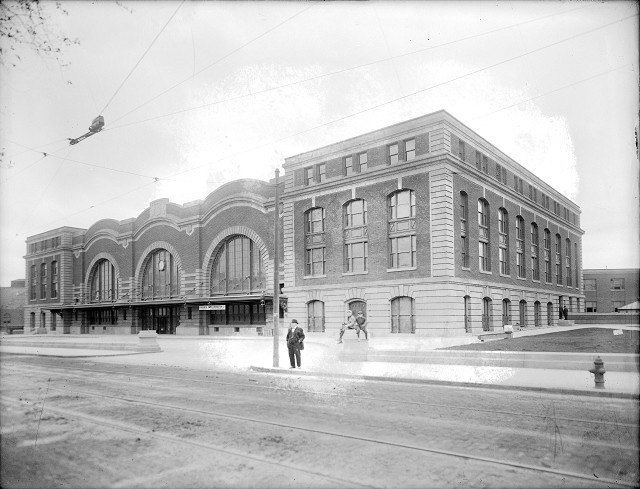There used to be a beautiful train station in Rochester, New York.
 The Rochester train station and Greyhound Bus stop sit at the corner of Central and Joseph Avenues, just north of Rochester’s infamous “inner loop,” a beltway that encircles downtown Rochester. Both the inner loop and the current transportation center are infrastructural eyesores and civic blunders. While the inner loop was intended to alleviate congestion and increase traffic flow in downtown Rochester, the city’s subsequent contraction has rendered the beltway effectively useless. Conversely, as train travel decreased throughout the post-war era, there was little need for grandiose train terminals. Like many other stations built during the early years of the twentieth century, the original Rochester train station was destroyed and replaced by what stands in its place today.
The Rochester train station and Greyhound Bus stop sit at the corner of Central and Joseph Avenues, just north of Rochester’s infamous “inner loop,” a beltway that encircles downtown Rochester. Both the inner loop and the current transportation center are infrastructural eyesores and civic blunders. While the inner loop was intended to alleviate congestion and increase traffic flow in downtown Rochester, the city’s subsequent contraction has rendered the beltway effectively useless. Conversely, as train travel decreased throughout the post-war era, there was little need for grandiose train terminals. Like many other stations built during the early years of the twentieth century, the original Rochester train station was destroyed and replaced by what stands in its place today.
The original train station, built for the New York Central Railroad between 1909 and 1913, was designed by architect and Theosophist Claude Bragdon. Bragdon’s architectural methodologies were clearly inspired by his contemporaries such as Louis Sullivan, arguably the most famous American architect of his time (second, perhaps, only to his protégé Frank Lloyd Wright). However, Bragdon’s relationship with Theosophy produced a different type of organic architecture, one in which the triad of Nature, Divinity, and Humanity was an organizing aesthetic principle. Such an approach, which employed the use of geometric patterns derived from nature, was intended to supplant the persistence of Beaux-Arts architecture with a transcendent and universal aesthetic experience.
The demolishment of Bragdon’s train station, its replacement station, and the inner loop project (along with Eastman Kodak’s fall and subsequent reemergence from bankruptcy) have all become symbolic representations of Rochester’s fate in the age of deindustrialization and urban decay. The narrative is acutely bleak and doggedly consistent. It seems as though any attempt to recreate the original train station in a digital environment would inevitably result in a nostalgic longing for the Rochester that was, but no longer is. However, The Bragdon Project has a number of goals that extend far beyond the preservation of the past.
Certainly, any recreation is intended to provide an experience of something that no longer exists. The oral histories and recollections that the project team has gathered (and continues to gather) from people who remember the station are intended to facilitate the memory-making process of those telling the stories, as well as provide some semblance of the experience of walking through the station for those who never had the opportunity. And yet, the experiential recreation of the Bragdon station has a number of implications for architectural historians, urban planners, and American historians alike. Most importantly, the project seeks to resuscitate and proliferate Bragdon’s reputation among American architects. Although he is virtually unknown outside of Rochester, Bragdon is certainly an important figure in the transitional period of early twentieth-century American architecture. Like Sullivan and Wright, he straddles the divide between the Arts and Crafts movement and modernism, and provides an alternative perspective on “organic architecture.” Additionally, the digital recreation of Rochester’s train station draws the ebb and flow of American industry and the experience of urbanity into sharp focus, challenging those who explore the digital terrain of early twentieth century Rochester to ask questions regarding the relationship between progress, infrastructure, economy, and daily life in regional centers.
—
Chris Patrello is a PhD student in the graduate program in Visual and Cultural Studies at the University of Rochester.
